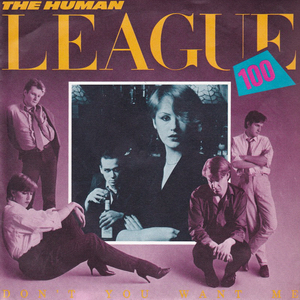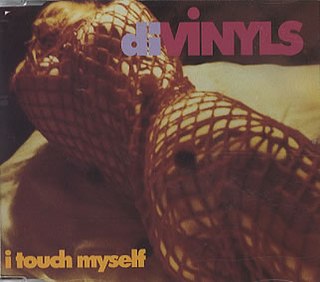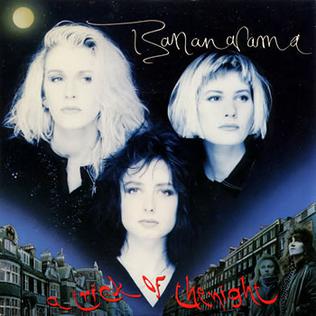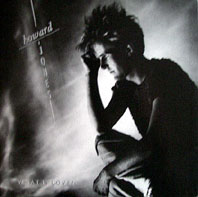
"Girls Just Want to Have Fun" is a song made famous by American singer-songwriter Cyndi Lauper four years after it was written by Robert Hazard. It was released by Portrait Records as Lauper's first major single as a solo artist and the lead single from her debut studio album, She's So Unusual (1983). Lauper's version gained recognition as a feminist anthem and was promoted by a Grammy-winning music video. It has been covered, either as a studio recording or in a live performance, by over 30 other artists.

"Closer" is a song by American industrial rock band Nine Inch Nails, released as the second single on their second studio album, The Downward Spiral (1994). Released in May 1994, it is considered one of Nine Inch Nails' signature songs and remains their most popular song. Most versions of the single are titled "Closer to God", a rare example in music of a single's title differing from the title of its A-side. The single is the ninth official Nine Inch Nails release, making it "Halo 9" in the band's official Halo numbering system.

"Don't You Want Me" is a song by British synth-pop group the Human League. It was released on 27 November 1981 as the fourth single from their third studio album, Dare (1981). The band's best known and most commercially successful song, it was the best selling UK single of 1981, that year's Christmas number one, and has since sold over 1,560,000 copies in the UK, making it the 23rd-most successful single in UK Singles Chart history. It topped the Billboard Hot 100 in the US on 3 July 1982, where it stayed for three weeks.

"I Want to Break Free" is a song by the British rock band Queen, written by their bassist John Deacon. It appears on the album The Works (1984), and was released in three versions: album, single and extended. The track became a staple of the band's 1984–85 Works Tour and their 1986 Magic Tour.

"Don't Dream It's Over" is a song by rock band Crowded House, recorded for their 1986 self-titled debut studio album. The song was composed and written by New Zealand frontman Neil Finn and released in October 1986 as the fourth single from the album.

"Solsbury Hill" is the debut solo single by English rock musician Peter Gabriel. He wrote the song about a spiritual experience atop Solsbury Hill in Somerset, England, after his departure from the progressive rock band Genesis, of which he had been the lead vocalist since its inception. The single was a Top 20 hit in the UK, peaking at number 13, and reached number 68 on the Billboard Hot 100 chart in 1977.

"I Touch Myself" is a song recorded by Australian rock band Divinyls. It was written by the songwriting team of Tom Kelly and Billy Steinberg along with Christine Amphlett and Mark McEntee of the Divinyls. It was released in November 1990 by Virgin as the lead single from the band's fourth album, Divinyls (1991), and deals with the subjects of eroticism and female masturbation. The single achieved success, reaching No. 1 in Australia and No. 4 on the US Billboard Hot 100. In January 2018, Australian network Triple M ranked the song at No. 60 in its list of the "most Australian" songs of all time. In 2023, Billboard magazine ranked it among the "500 Best Pop Songs of All Time".

"Cover Girl" is a 1989 single from New Kids on the Block. The lead vocals were sung by Donnie Wahlberg. The fifth and final single from their multi-platinum second studio album Hangin' Tough (1988), it peaked at number two on the Billboard Hot 100 on the week of November 4, being held off from the top spot by Roxette's "Listen to Your Heart". The song became fifth consecutive top 10 single from album onBillboard Hot 100, making NKOTB the first teen act to gain such chart success.

"Mr. Jones" is the debut single of American rock band Counting Crows. It was released in December 1993 by Geffen as the lead single from the band's debut album, August and Everything After (1993). The song was the band's first radio hit and has been described as their breakout single. "Mr. Jones" reached number five on the Billboard Hot 100 Airplay charts. Internationally, the song peaked at number one in Canada and number seven in France. In April 2022, American Songwriter ranked the song at number four on their list of "The Top 10 Counting Crows Songs".

"Duality" is a song by American heavy metal band Slipknot. It was released on May 4, 2004, as the first single from the band's third album, Vol. 3: . A music video was made for the song, which was listed as Roadrunner's greatest video of all-time.

"Freak Like Me" is a song by American R&B singer Adina Howard, released on January 25, 1995 by East West and Lola Waxx, as the debut single from her first album, Do You Wanna Ride? (1995). The song reached number two on the US Billboard Hot 100 for two weeks, as well as number two on the Billboard Hot R&B Singles chart for four weeks, and was certified platinum by the Recording Industry Association of America (RIAA) for sales of one million copies. Its music video was directed by Hype Williams. In 2023, Billboard ranked "Freak Like Me" among the "500 Best Pop Songs of All Time". The song has been covered by several artists, including British girl group Sugababes, who reached number one on the UK Singles Chart with their version in 2002.

"Make Me Smile (Come Up and See Me)" is a song by the English rock band Steve Harley & Cockney Rebel, which was released in 1975 by EMI as the lead single from the band's third studio album The Best Years of Our Lives. The song was written by Harley, and produced by Harley and Alan Parsons. In February 1975, the song reached number one on the UK chart and received a gold certification from the British Phonographic Industry in October 2021. It spent nine weeks in the Top 50, and as of 2015, has sold over 1.5 million copies worldwide. The song is one of the most-played songs in British broadcasting history.

"Sweet Dreams (Are Made of This)" is a song by British synth-pop duo Eurythmics. It was released as the fourth and final single from their second album of the same name in January 1983. It was their breakthrough hit, establishing the duo worldwide. It reached number two on the UK Singles Chart in March 1983, and number one on the US Billboard Hot 100 six months later; it was their first single released in the US.

"A Trick of the Night" is a mid-tempo ballad recorded by English girl group Bananarama. It was written and produced by Steve Jolley and Tony Swain and released as the final single from Bananarama's album True Confessions.

"Burning Down the House" is a song by new wave band Talking Heads, released in July 1983 as the first single from their fifth studio album Speaking in Tongues.

"All I Wanna Do Is Make Love to You" is a song by American rock band Heart. It was composed by veteran songwriter and producer Robert John "Mutt" Lange and released as the lead single from the band's tenth studio album, Brigade, in March 1990. The song was first recorded as "All I Want to Do Is Make Love to You" by Dobie Gray in 1979, though with different lyrics. The Heart version tells the story of a woman who sets out to seduce a hitchhiker in order to become pregnant because although there is a man in her life, he is infertile.

"Love Is the Drug" is a song by the English rock band Roxy Music, from their fifth studio album, Siren (1975), released as a single in September 1975. Co-written by Bryan Ferry and Andy Mackay, the song originated as a slower, dreamier track until the band transformed its arrangement to become more dance-friendly and uptempo. Ferry's lyrics recount a man going out looking for action.

"It Only Takes a Minute" is a 1975 song by American soul/R&B group Tavares, released as the first single from their third album, In the City (1975). The song was the group's only top-10 pop hit in the United States, peaking at number 10, and their second number one song on the American soul charts. On the US Disco chart, "It Only Takes a Minute" spent five weeks at number two and was the first of four entries on the chart. The song was subsequently covered by Jonathan King performing as 100 Ton and a Feather in 1976 and by boy band Take That in 1992.

"What Is Love?" is a song by English musician Howard Jones, released in November 1983 as the second single from his debut studio album, Human's Lib (1984). It reached number 2 on the UK Singles Chart, becoming the singer's highest chart placing to date. In the US, it peaked at number 33 on the Billboard Hot 100.

The singles discography of American country artist, George Jones, contains 182 singles. Of the total, 136 were released with Jones as the solo artist. In addition, 31 were issued with Jones being part of a collaboration. Thirdly, eight singles were issued with Jones being part of a featured act. Fourthly, seven released were promotional singles. Additionally, 14 songs that are not released as singles are included that made any major chart. Finally, 21 music videos which were first issued as singles are also listed. Jones had his first chart success in 1955 with several top ten Billboard Hot Country Songs singles: "Why Baby Why", "What Am I Worth" and "You Gotta Be My Baby". After several more top ten releases, "White Lightning" became his first to top the Billboard country chart. Along with "Who Shot Sam", both singles were also his first to make the Hot 100 charts.




















